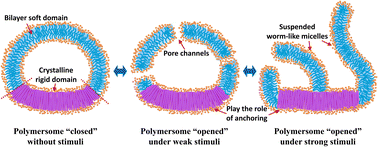Designing polymersomes with inhomogeneous membranes by co-assembly of block copolymers for controlled morphological reversibility†
Abstract
Polymersomes with inhomogeneous membranes in composition and structure have generated widespread interest for the preparation of functionalized nanocarriers. We propose a simple but versatile strategy to manipulate inhomogeneous subdomains on polymersome membranes by the co-assembly of block copolymer blends with varied molecular architectures and chemistries. Both binary and ternary copolymer blends are considered to construct polymersomes, and the subdomains of the membranes are formed by controlling the difference in the flexibility and rigidity of different blocks. This difference contributes to the formation of disk-like domains (by rigid blocks) and soft domains (by flexible blocks) on the membrane. An interesting effect of this structure is that in response to external stimuli, the soft membrane domain becomes worm-like or porous to “open” the polymersome for matter exchange, while the rigid domain stays undecomposed and acts like an anchor binding all flexible copolymers. Once the external stimuli disappear, all flexible copolymers can be pulled back to restore the original polymersome morphology (i.e., “close” the polymersome). The specific morphological reversibility of hybrid polymersomes holds great potential for practical applications where changeable membrane permeability or shape under environmental stimuli is highly needed.



 Please wait while we load your content...
Please wait while we load your content...